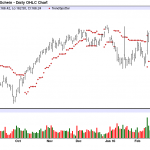The Federal Reserve’s years-long campaign to sheepishly back away from its own policy forecasts continued in earnest last week when it officially reduced the four expected 2016 quarter point hikes, suggested back in December, to just two. Given the deteriorating economic outlook, I believe there can be little doubt that the Fed will soon complete the capitulation process and remove all expectations for additional hikes this year. Even before that happens, savvy observers should have already concluded that the Federal Reserve is stuck in the monetary mud just as firmly now as it has been since the dawn of the financial crisis back in 2008.
Rather than actively voicing its retreat in either its March policy statement or in Chairwoman Janet Yellen’s press conference, the market-moving policy shift was buried in the minutia of the Fed’s “dot plot” information array, in which each voting committee member signals their assumptions of where interest rates will be in various points in the future. Those tea leaves needed to be read to reach the conclusion that policy just got significantly more dovish. But despite the Fed’s soft peddling, the policy shift made an immediate impact on markets, with the dollar getting hit by a variety of rival currencies and gold (and more significantly gold miners) climbing to multi-month highs.
But perhaps the greatest casualty of the announcement was the Fed’s own credibility, which is now being stretched to the limit. At Yellen’s press conference last Wednesday, CNBC reporter Steve Liesman, who has perhaps been one of the most reliable supporters of the Fed’s policies, seemed to indicate that even he had grown weary of the Fed’s prevarications, saying to Chairman Yellen: “Does the Fed have a credibility problem in the sense that it says it will do one thing under certain conditions, but doesn’t end up doing it? And…if the current conditions are not sufficient for the Fed to raise rates,…what would those conditions ever look like?”













Leave A Comment